The Atom-Bond Connectivity Index of Catacondensed Polyomino Graphs
Abstract
Let G = (V, E) be a graph. The atom-bond connectivity (ABC) index is defined as the sum of weights over all edges uv of G, where du denotes the degree of a vertex u of G. In this paper, we give the atom-bond connectivity index of the zigzag chain polyomino graphs. Meanwhile, we obtain the sharp upper bound on the atom-bond connectivity index of catacondensed polyomino graphs with h squares and determine the corresponding extremal graphs.
1. Introduction
One of the most active fields of research in contemporary chemical graph theory is the study of topological indices (graph topological invariants) that can be used for describing and predicting physicochemical and pharmacological properties of organic compounds. In chemistry and for chemical graphs, these invariant numbers are known as the topological indices. There are many publications on the topological indices, see [1–6].
The ABC index keeps the spirit of the Randić index, and it provides a good model for the stability of linear and branched alkanes as well as the strain energy of cycloalkanes [7]. Recently, the study of the ABC index attracts some research attention [6, 8–12].
Polyomino graphs [13], also called chessboards [14] or square-cell configurations [15] have attracted some mathematicians’ considerable attention because many interesting combinatorial subjects are yielded from them such as domination problem and modeling problems of surface chemistry. A polyomino graph [16] is a connected geometric graph obtained by arranging congruent regular squares of side length 1 (called a cell) in a plane such that two squares are either disjoint or have a common edge. The polyomino graph has received considerable attentions.
Next, we introduce some graph definitions used in this paper.
Definition 1 (see [4].)Let G be a polyomino graph. If all vertices of G lie on its perimeter, then G is said to be catacondensed polyomino graph or tree-like polyomino graph. (see Figure 1).
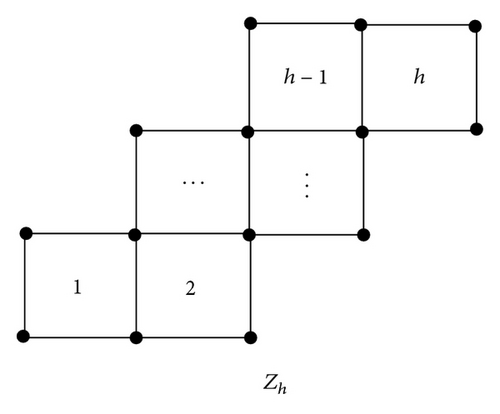
Definition 2 (see [16].)Let G be a chain polyomino graph with h squares. If the subgraph obtained from G by deleting all the vertices of degree 2 and all the edges adjacent to the vertices is a path, then G is said to be the zigzag chain polyomino graph, denoted by Zh (see Figure 1).
In this paper, we give the ABC indices of the zigzag chain polyomino graphs with h squares and obtain the sharp upper bound on the ABC indices of catacondensed polyomino graphs with h squares and determine the corresponding extremal graphs.
2. The ABC Indices of Catacondensed Polyomino Graphs
Note that for any catacondensed polyomino graph H* with h squares, it can be obtained by gluing a new square s to some catacondensed polyomino graph H with h − 1 squares. So, we have the following lemma.
Lemma 3. Let H* be a catacondensed polyomino graph with h squares which is obtained by gluing a new square s to some graph H, where H is a catacondensed polyomino graph with h − 1 squares. One has
- (i)
If 2 ≤ h ≤ 3, then ABC(H*) − ABC(H) ∈ S1,
- (ii)
if h ≥ 4, then ABC(H*) − ABC(H) ∈ S2.
Proof. Consider the following: (i) if 2 ≤ h ≤ 3, by directly calculating, we have ABC(H*) − ABC(H) ∈ S1,
(ii) now, let h ≥ 4. Without the loss of generality, let square s be adjacent to the edge AB in H (see Figure 2). In the following, if the weights of some edges of H have been changed when s is adjacent to the edge AB in H, then we marked these edges with thick lines in H*. Let Di = ABC(H*) − ABC(H) (i = 1,2, …, 35). Note that except the edge AB of s, the summation of the weights of the remaining three edges is always in H*. There are exactly three types of formations (see Figure 2).
Case 1. In Type I, and (see Figure 3).
By the definition of ABC index, we have ABC(H*) − ABC(H) = + + + = Di (i = 1,2, 3).
-
If du = 3 and dv = 3, then D1 = 2.
-
If du = 3 and dv = 4 or du = 4 and dv = 3, then .
-
If du = 4 and dv = 4, then .
Let u adjacent to A and v, w adjacent to B (see Figure 4). Then du ∈ {2,3, 4}, dv ∈ {3,4}, and dw ∈ {2,3, 4}. If du = 2, dv = 3, and dw = 2, which is in contradiction with h ≥ 4; if du = 3 and dv = 3, which is in contradiction with ; if du = 4 and dv = 3, which is in contradiction with (A ∈ V(H)).
By the definition of ABC index, we have ABC(H*) − ABC(H) = + + + + = Di (i = 4,5, …, 14).
-
If du = 2, dv = 3, and dw = 3, then .
-
If du = 2, dv = 3, and dw = 4, then .
-
If du = 2, dv = 4, and dw = 2, then .
-
If du = 2, dv = 4, and dw = 3, then .
-
If du = 2, dv = 4, and dw = 4, then .
-
If du = 3, dv = 4, and dw = 2, then .
-
If du = 3, dv = 4, and dw = 3, then .
-
If du = 3, dv = 4, and dw = 4, then .
-
If du = 4, dv = 4, and dw = 2, then .
-
If du = 4, dv = 4, and dw = 3, then .
-
If du = 4, dv = 4, and dw = 4, then .
Case 3. In Type III, and (see Figure 5).
Let u, x adjacent to A and v, w adjacent to B (see Figure 5). Then, du ∈ {3,4}, dv ∈ {3,4}, dw ∈ {2,3, 4}, and dx ∈ {2,3, 4}. Since the case du = 3, dv = 4, dx = y1, and dw = y2 is the same as du = 4, dv = 3, dx = y2, and dw = y1, where y1, y2 ∈ {2,3, 4}. And note that if du = dv = 3 or du = dv = 4, the vertices x and w are symmetric.
By the definition of ABC index, we have (i = 15,16, …, 35).
-
If du = dv = 3, dx = 2, and dw = 3, then .
-
If du = dv = 3, dx = 2, and dw = 4, then .
-
If du = dv = 3, dx = 3, and dw = 3, then .
-
If du = dv = 3, dx = 3, and dw = 4, then .
-
If du = dv = 3, dx = 4, and dw = 4, then .
-
If du = dv = 4, dx = 2, and dw = 2, then .
-
If du = dv = 4, dx = 2, and dw = 3, then .
-
If du = dv = 4, dx = 2, and dw = 4, then .
-
If du = dv = 4, dx = 3, and dw = 3, then .
-
If du = dv = 4, dx = 3, and dw = 4, then .
-
If du = dv = 4, dx = 4, and dw = 4, then .
-
If du = 3, dv = 4, dx = 2, and dw = 2, then .
-
If du = 3, dv = 4, dx = 2, and dw = 3, then .
-
If du = 3, dv = 4, dx = 2, and dw = 4, then .
-
If du = 3, dv = 4, dx = 3, and dw = 2, then .
-
If du = 3, dv = 4, dx = 3, and dw = 3, then .
-
If du = 3, dv = 4, dx = 3, and dw = 4, then .
-
If du = 3, dv = 4, dx = 4, and dw = 2, then .
-
If du = 3, dv = 4, dx = 4, and dw = 3, then .
-
If du = 3, dv = 4, dx = 4, and dw = 4, then .
-
If du = 3, dv = 3, dx = 2, and dw = 2, then .
By directly calculating, we have D5 = D7, D10 = D12, D16 = D27 = D29, D18 = D30, D19 = D23 = D31 = D33, D21 = D28 = D32, D24 = D34, and D6 = max 1≤i≤35Di, D14 = min 1≤i≤35Di. So ABC(H*) − ABC(H) ∈ S2, where h ≥ 4.
Therefore, ABC(H*) − ABC(H) ∈ S.
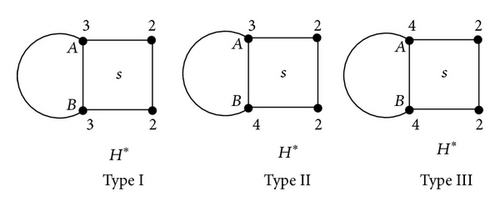
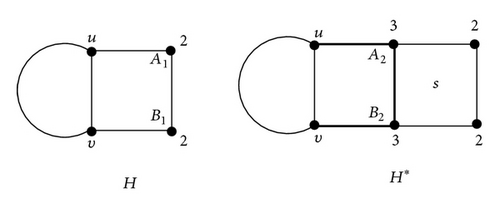
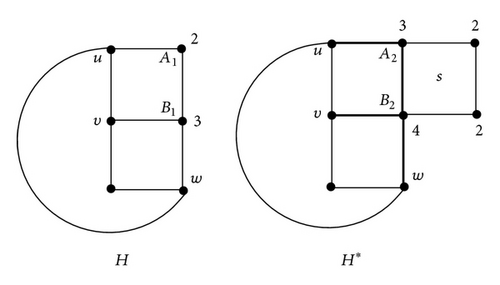
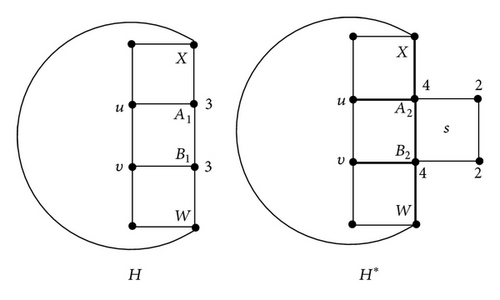
By Lemma 3, we have the following theorem.
Theorem 4. Let G be a catacondensed polyomino graph with h (h ≥ 2) squares, then
Proof. We prove Theorem 4 by the induction on h. If h = 2, by directly calculating, we have , where ai = 0 (i = 1,2, …, 25). So, Theorem 4 holds for h = 2.
Assume that Theorem 4 holds for all catacondensed polyomino graphs with h − 1 (h − 1 ≥ 2) squares, that is,
We will prove that Theorem 4 holds for h in the following. Let G* be a catacondensed polyomino graph with h squares. Without the loss of generality, G* can be obtained from some catacondensed polyomino graph G with h − 1 squares by gluing a new square s to G. By Lemma 3, we have ABC(G*) − ABC(G) ∈ S. It means that ABC(G*) = ABC(G) + a, where a ∈ S. By the induction assumption and direct computation, we have
Lemma 5. Let H be a catacondensed polyomino graph with h squares. If h ≤ 3, there are exactly four nonisomorphism catacondensed polyomino graphs (see Figure 6), where , , , .
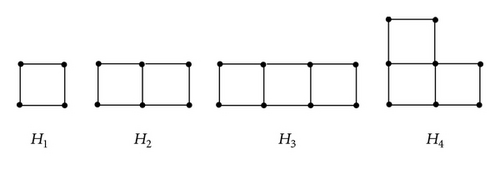
Theorem 6. Let Zh be a zigzag chain polyomino graph with h squares, then
Proof. Obviously, Zh can be obtained by gluing a new square sh to Zh−1. Let sh−1 be the square adjacent to sh (see Figure 1). We will prove Theorem 6 by the induction on h.
If h = 1,2, 3, then Theorem 6 holds (by Lemma 5). Assume that for h − 1 ≥ 3. By the induction assumption and the D6 in Lemma 3, we have
So, Theorem 6 holds.
Note that D6 = max 1≤i≤35 Di for h ≥ 4 and by Lemma 5, we obtain the following Theorem 7.
Theorem 7. Let G be a catacondensed polyomino graph with h squares, then , with the equality if and only if G≅Zh.
Acknowledgments
The project was supported by NSFC (no. 11071272; 11101086; 11101087) and the Foundation of Fuzhou University (no. 2012-XQ-30).




